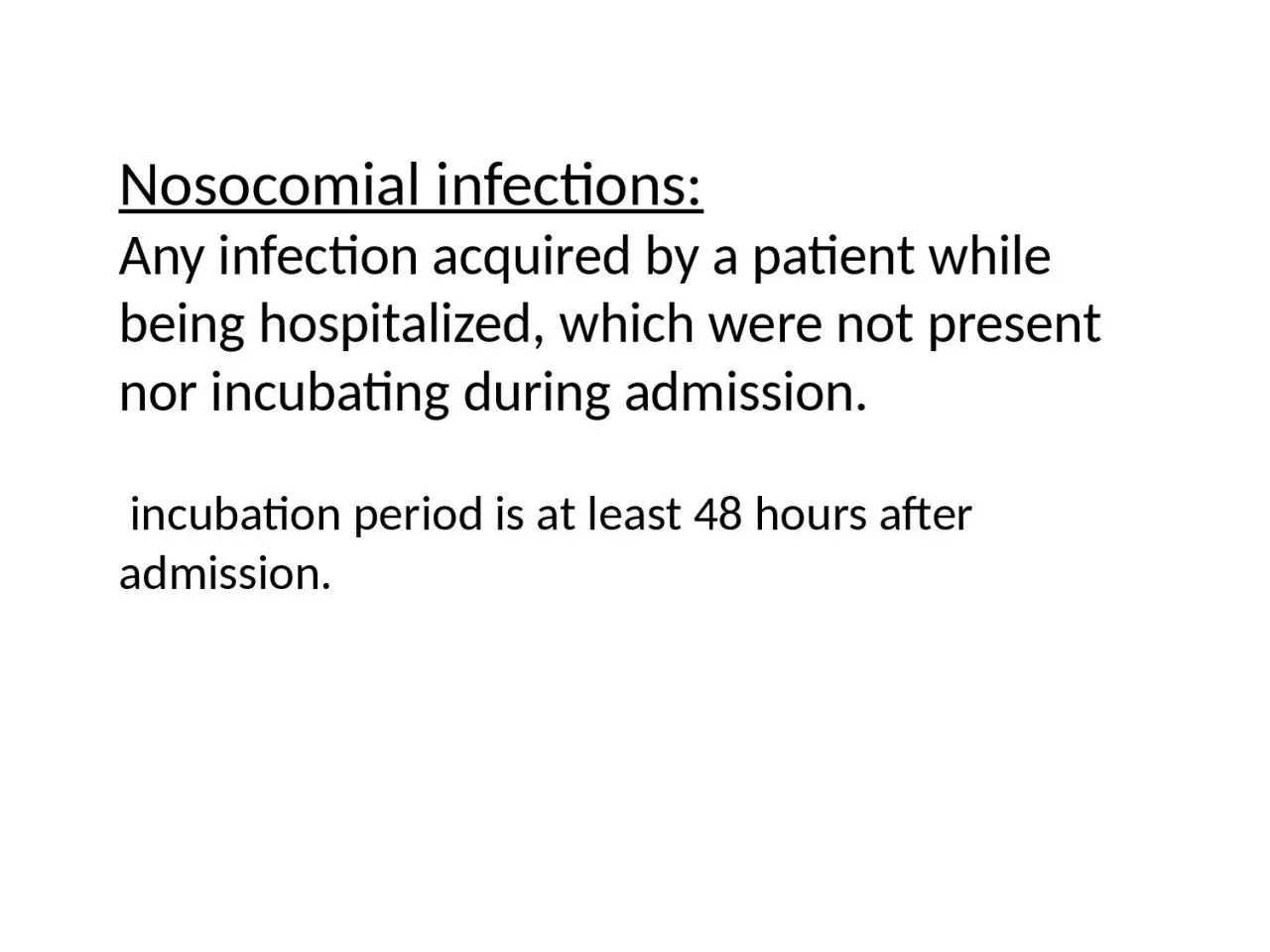

being hospitalized which were not present nor incubating during admission incubation period is at least 48 hours after admission Sources of nosocomial infections 1 ENDOGENOUS SOURCES 50 ID: 928913
Download Presentation The PPT/PDF document "Nosocomial infections: Any infection acq..." is the property of its rightful owner. Permission is granted to download and print the materials on this web site for personal, non-commercial use only, and to display it on your personal computer provided you do not modify the materials and that you retain all copyright notices contained in the materials. By downloading content from our website, you accept the terms of this agreement.
Slide1
Nosocomial infections:
Any infection acquired by a patient while
being hospitalized
, which were not present nor incubating during admission.
incubation period is at least 48 hours after admission.
Slide2Sources of
nosocomial infections:1. ENDOGENOUS SOURCES ------(50%) Patients own flora - - Auto-Infection 2. EXOGENOUS SOURCES----(50%)
Other patients
Health care
prsonnel
”carriers”
Medications & treatments
Visitors
Fomites
(bed sheets, instruments)
Hospital Environment
(Air, food, water)
Slide3Predisposing factors of
nosocomial infectionsHOST FACTORS Age Health status
underlying disease
Immune status
Slide42. TREATMENT
Surgery Instruments & foreign bodies introduced Theraputic agents
Immunosuppressive drugs
Ionizing radiation
Broad spectrum antibiotics
Length of hospitalization
Slide5Classification of surgical procedures
Cleanno entry into GI/GU/Resp tractlow riskinfection usually exogenous
Clean contaminated
no significant spillage
e.g. cholecystectomy
infection rates 5-10 %
Contaminated
Significant spillage of bacteria expected Infection rate 18-20%
Dirty
Perforated viscus drainage of
abscess Infection rate often >30%
Slide63. ENVIRONMENT
Overcrowding of patients Air & inaniment objects Medical devices
Slide7IMPORTANT CROSS-INFECTION ORGANISMS
Slide8Rate of CROSS-INFECTION ORGANISMS
Slide9Methicillin
resistant Staph. aureus(MRSA) Resistant to Flucoxacillin and usually others
Sources:
- Hospital personnel carriers
Colonization
on
nares
,
axilla, perineum,
hands
- Patients
Wounds/Lesions
May cause
:
Wound infection
Bacteraemia
Skin/soft tissue infection
U.T.I.
Pneumonia etc.
Slide10Methicillin
resistant Staph. aureus(MRSA)------(cont)
Spread By:
Hands
Fomites
Aerosols
Becoming more common in the Community
Control:
Eradication
of
carriers
Barrier nursing
Screening of other patients Staff
Slide11TUBERCULOSIS
Open pulmonary TB (Sputum smear positive for AFB) VIRAL INFECTIONS
Chicken Pox
(Hepatitis B HIV)
Slide12Resistant Gram Negative Bacteria
Resistance to multiple antibiotics Organisms:
E .coli
Proteus
Enterobacter
Acinetobacter
Pseudomonas
aeruginosa
Slide13Resistant Gram Negative Bacteria----(
cont) May Cause: Bacteraemia
U.T.I.
Pneumonia
Wound infection
Control:
Antibiotic Policy
Control of Infection Guidelines
Prevention of Cross Infection especially on high risk areas
Slide14Implications of
nosocomial infectionsConsequences for patients: Affects approx. 10% of all in-patients delays discharge
delay post-operative wound healing
prolonged suffering
direct
cause deaths
2. Consequences for the community:
Healthy personnel acquire infections
Dessiminate
pathogens to the
community”carriers
”
Slide15Implications of
nosocomial infections-----cont 3. Consequences for the hospital:
Malpractice suits.
Financial loss
(estimated loss > 2 billion$/year)
Slide16General preventive principles
Good general ward hygiene: - No overcrowding - Good ventilation
- Regular removal of dust
- Wound dressing early in day
- Disposable equipment
- Preventing cross infection
HAND WASHING
most important -
Before
and after patient contact
Before
invasive procedures
Slide17PREVENTING CROSS INFECTION
If known or suspected on admission to hospital, or detected following admission:
-
Isolation (barrier precautions)
-
Inform Infection Control team
-
Treatment - if appropriate
-
Regular surveillance
Slide18Slide19Slide20Wound, skin & blood
precations
Slide21Enteric precautions
Respiratory precautions
Slide22Protective isolation
Slide23Hand hygiene is the simplest, most effective measure for preventing hospital-acquired infections.
Slide24Hospital
proceedures that lead to colonizationof germs on hands
Healthcare
workers can get 100s to 1000s of bacteria on their hands by doing simple tasks like:
pulling patients up in bed
taking a blood pressure or pulse
touching a patient’s hand
rolling patients over in bed
touching the patient’s gown or bed sheets
touching equipment like bedside rails,
overbed
tables, IV pumps
Slide25